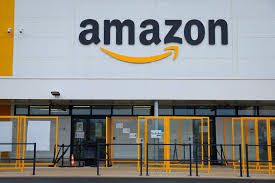Maximizing Business on Amazon: A Step-by-Step Guide for New Business Owners
Are you looking to start a business on Amazon and leverage the massive reach and customer base of Amazon? With over 300 million active customers worldwide, Amazon is a powerful platform for aspiring entrepreneurs to launch their business and sell products.
Whether you’re a seasoned business owner or just starting out, Amazon offers incredible opportunities to tap into the e-commerce market. Here’s a step-by-step guide on how to start a business on Amazon.
Research and Choose Your Niche: The first step to starting any successful business is to identify your niche. Research the market and identify products that are in demand but have relatively low competition.
Look for products that align with your interests, passions, and expertise. It’s also essential to consider factors like profit margins, product size, and shipping requirements when selecting your niche.
Create a Business Plan: Just like any other business, an Amazon business also requires a well-thought-out business plan. Outline your business goals, target market, competitive analysis, marketing strategies, and financial projections. A business plan will serve as a roadmap and help you stay focused on your objectives.
Register Your Business: To sell on Amazon, you’ll need to register your business. Choose a business entity type, such as sole proprietorship, partnership, or LLC, and register your business with the appropriate government authorities. You’ll also need to obtain any necessary permits or licenses, depending on your location and the type of products you plan to sell.
Set Up Your Amazon Seller Account: Next, you’ll need to set up your Amazon Seller Account. Choose between an Individual Seller Account, which has no monthly fee but charges a per-item fee, or a Professional Seller Account, which has a monthly subscription fee but offers additional benefits like access to more product categories and features. Follow the step-by-step instructions provided by Amazon to set up your account.
Source Your Products: Once your seller account is set up, you’ll need to source your products. You can choose to sell products that you manufacture yourself, products from wholesale suppliers, or products from third-party manufacturers or distributors. Consider factors like product quality, pricing, shipping costs, and supplier reliability when sourcing your products.
Create Your Product Listings: Your product listings on Amazon are crucial for attracting customers. Optimize your product listings with high-quality product images, detailed product descriptions, and relevant keywords. Use Amazon’s tools like Enhanced Brand Content or A+ Content to enhance your product listings and make them stand out.
Fulfillment Method: Decide on your fulfillment method. You can either fulfill orders yourself (Merchant Fulfilled Network or MFN) or use Amazon’s fulfillment services (Fulfillment by Amazon or FBA). With FBA, Amazon takes care of storing, packing, and shipping your products, while you focus on marketing and customer service.
Implement Marketing Strategies: To succeed on Amazon, you’ll need to implement effective marketing strategies to drive traffic and sales. Utilize Amazon’s advertising options like Sponsored Products, Sponsored Brands, and Sponsored Display to increase your product visibility.
You can also leverage social media, email marketing, content marketing, and other digital marketing techniques to promote your products and build a brand presence.
Provide Excellent Customer Service: Customer reviews and ratings are crucial for success on Amazon. Provide exceptional customer service by promptly responding to customer inquiries, addressing complaints, and resolving issues. Encourage customers to leave reviews and feedback on your product listings, as positive reviews can boost your sales and credibility.
Monitor and Optimize Your Business: Continuously monitor your Amazon business performance, including sales, profits, inventory levels, and customer feedback. Analyze the data and make necessary adjustments to optimize your business.
Experiment with different pricing strategies, product variations, and marketing campaigns to find what works best for your business.
Read Also: Kid Entrepreneur: How to Launch and Grow Your Business
Selling on Amazon

Amazon is one of the world’s largest e-commerce platforms, with over 300 million active customers worldwide. As a result, selling on Amazon can be a lucrative opportunity for individuals and businesses looking to expand their reach and increase their sales. However, the process of getting started can seem daunting.
Step 1: Create a Seller Account
The first step to selling on Amazon is to create a seller account. Amazon offers two types of seller accounts: individual and professional. The individual account is suitable for individuals or businesses with a small number of items to sell. The professional account is intended for those who plan to sell large volumes of products.
To create a seller account, visit the Amazon Seller Central website and follow the prompts to register. Amazon will ask for basic information such as your name, address, and phone number. You will also need to provide a credit card or bank account to receive payments from Amazon.
Step 2: List Your Products
Once you have created a seller account, the next step is to list your products on Amazon. To do this, you will need to create a product listing. A product listing is a description of your product that includes information such as its title, description, price, and images.
To create a product listing, navigate to the “Inventory” tab in your seller account and select “Add a Product.” You will then be prompted to enter information about your product, such as its name, brand, and UPC (Universal Product Code) or ISBN (International Standard Book Number).
Step 3: Optimize Your Listings
After creating a product listing, it’s important to optimize it for maximum visibility and sales. This involves using keywords and other techniques to make your listing more attractive to potential buyers.
One way to optimize your listings is to use Amazon’s search algorithm to your advantage. This involves using relevant keywords in your product title and description, as well as including high-quality images and detailed product information.
Step 4: Manage Orders
Once your products are listed on Amazon, you will begin receiving orders from customers. Amazon provides a range of tools to help you manage your orders, including order reports, shipping options, and customer communication.
To manage orders, navigate to the “Orders” tab in your seller account. From here, you can view and manage orders, print shipping labels, and communicate with customers.
Step 5: Fulfillment Options
Amazon offers several fulfillment options for sellers. These include Fulfillment by Amazon (FBA), Fulfillment by Merchant (FBM), and Seller Fulfilled Prime (SFP).
Fulfillment by Amazon (FBA) is a program where Amazon stores and ships your products for you. Fulfillment by Merchant (FBM) is where you store and ship your products yourself. Seller Fulfilled Prime (SFP) is where you fulfill Prime orders yourself, but Amazon provides the Prime badge for your listings.
Each fulfillment option has its own advantages and disadvantages, so it’s important to choose the option that best suits your business needs.
Selling on Amazon can be a great opportunity for individuals and businesses to expand their reach and increase their sales. By following the steps outlined in this article, you can create a successful Amazon seller account and start selling your products to millions of customers worldwide.
Amazon Seller Account Setup
Setting up an Amazon seller account is a great way to reach a large customer base and grow your business. With millions of active users, Amazon is one of the largest marketplaces in the world, and having your products listed on the platform can help increase your visibility and sales.
To get started with setting up your Amazon seller account, follow these simple steps:
Step 1: Create Your Amazon Seller Account
The first step is to create your Amazon seller account. To do this, visit the Amazon Seller Central website and click on the “Register Now” button. You will be prompted to provide some basic information about yourself and your business, such as your name, email address, business name, and address.
Step 2: Choose Your Selling Plan
Once you have created your Amazon seller account, you will need to choose your selling plan. Amazon offers two plans: the Individual plan and the Professional plan. The Individual plan is best for those who plan to sell fewer than 40 items per month, while the Professional plan is better for those who plan to sell more than 40 items per month.
Step 3: List Your Products
Once you have chosen your selling plan, you can begin listing your products on Amazon. To do this, click on the “Add a Product” button in your Amazon seller account dashboard. You can either add your products one at a time or use Amazon’s bulk upload feature to add multiple products at once.
Step 4: Set Your Price and Shipping Options
After you have listed your products on Amazon, you will need to set your price and shipping options. Amazon offers several different pricing options, including fixed prices, auctions, and promotions. You can also choose to offer free shipping or charge a shipping fee.
Step 5: Start Selling
Once you have set up your Amazon seller account and listed your products, you can start selling. Amazon provides a number of tools and resources to help you manage your orders, track your inventory, and communicate with your customers.
In addition to these basic steps, there are several other things you can do to optimize your Amazon seller account and maximize your sales. For example, you can use Amazon’s advertising tools to promote your products and increase your visibility, or you can use Amazon’s fulfillment services to handle your shipping and customer service needs.
Setting up an Amazon seller account is a great way to reach a large audience and grow your business. By following these simple steps and taking advantage of Amazon’s many tools and resources, you can start selling on Amazon and reach millions of potential customers around the world.
Read Also: Instagram Business: How to Get Started
Amazon Listing Optimization

In the world of e-commerce, Amazon has become one of the most popular and lucrative platforms for businesses to sell their products. However, with millions of products available for purchase on Amazon, it can be challenging for businesses to stand out from the competition and make sales. This is where Amazon product listing optimization comes in.
Amazon product listing optimization is the process of optimizing a product listing to increase visibility, improve conversion rates, and ultimately drive more sales. In this article, we will discuss some of the best practices for optimizing your Amazon product listings.
Keyword Research: The first step in Amazon product listing optimization is keyword research. Keywords are the words or phrases that customers use to search for products on Amazon. By conducting keyword research, you can identify the most relevant and high-traffic keywords for your product.
To conduct keyword research, you can use Amazon’s own search bar to see what suggestions come up when you start typing in your product name or category. You can also use third-party tools like Google Keyword Planner or Ahrefs to identify high-traffic keywords that your target audience is searching for.
Title Optimization: Your product title is one of the most critical elements of your product listing. It should be clear, concise, and include your primary keywords. Amazon allows you up to 200 characters for your title, so make sure to use them wisely.
When optimizing your title, include the following:
- Brand name
- Product name
- Key features or benefits
- Size, color, or other relevant variations
For example, if you are selling a black leather wallet, your optimized title might look like this: “Brand Name – Black Leather Wallet for Men and Women – RFID Blocking – Multiple Card Slots – Slim Design.”
Bullet Points and Description Optimization
Your bullet points and description are your opportunity to provide more information about your product, its features, and its benefits. Use bullet points to highlight the key features and benefits of your product, and make sure to include your primary keywords.
In your product description, provide additional details about your product, including how it works, what it’s made of, and how it will benefit the customer. Make sure to include your primary keywords throughout your description, but don’t overdo it.
Images and Videos: Images and videos are essential elements of your product listing. High-quality images can help you stand out from the competition and give customers a better idea of what your product looks like. Make sure to include multiple images that show your product from different angles and include any relevant details.
If possible, include a video that demonstrates your product in action. This can help customers understand how your product works and what its benefits are.
Reviews and Ratings: Reviews and ratings are critical to the success of your product listing. Customers are more likely to purchase a product with positive reviews and ratings.
Encourage your customers to leave reviews by sending follow-up emails after their purchase, and make sure to respond to any negative reviews to show that you are listening to your customers’ feedback.
Amazon product listing optimization is an essential part of any successful e-commerce strategy. By following these best practices, you can increase your visibility, improve your conversion rates, and ultimately drive more sales on the Amazon platform.
Read Also: Low-Calorie Alchoholic Drinks to Try




